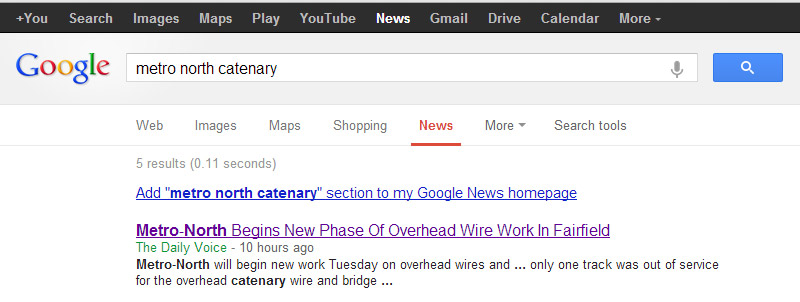https://twitter.com/FairfieldDV/status/312595576946561024
Having worked at newspapers for a good chunk of my life, I certainly take the business of journalism seriously, and especially the slow and steady march to online journalism (although, having done page production, it makes me a bit sad that layout may go away at some point).
As a technologist, I applaud unique efforts on websites, and as a former copy editor I cringe at bad missteps. Today, a series of steps led me to a cringe-worthy moment, and a potential ethical issue.
It started when a former colleague of mine retweeted the tweet above, from the hyperlocal Fairfield Daily Voice news website, about catenary work on the New Haven Line of Metro-North. Given the article on the MTA website hasn’t been updated in a year, despite a big bold UPDATE next to the link to it on the Metro-North landing page, I was hoping to see some word as to where they were.
Alas, the bullets about what was going on were awfully familiar, and when I looked at what they sourced, they sourced this page on the MTA site talking about how “work resumed” on March 19 after pausing in December, 2011 for the winter (which should’ve been an early hint).
If you look at the main catenary page on the site, you’ll see the updates are indeed a year old. (Slap on the wrists to the MTA for not updating more often; it’s an important project.)
I posted a comment on the article and tweeted the Daily Voice about the mistake:
@FairfieldDV @GreillyPost The MNR press release this is based off of is from 2012 (note the past tense). Just left a link in the comments.
— Joshua O'Connell (@jjofriends) March 15, 2013
When I checked back later, the article was gone. There was no reference to it on the site that it had been taken down or a correction that they had published an outdated and inaccurate article. As of this writing it was still lingering in Google News, and the tweet still in their feed, but the link itself just redirects to their news page:

This leads to my dilemma. While I was happy to see that bad information was eliminated, the fact that the article disappeared altogether concerned me. When you publish bad information in a print newspaper, a correction will surely follow (and it’s likely that they will regret the error). Online, it can just disappear, and people who read the article would be none the wiser. The fact that people can trip across articles randomly only increases that possibility.
Last summer I wrote on my company’s blog about NewsDiffs, a service that shed light on the revision history of articles at certain major publications, starting with organizations like the New York Times (and, happily, I see they’ve expanded their efforts since). Even though a major editor of the New York Times had said that it would be difficult to implement version tracking, a former reporter and some tech-savvy friends used standard version-control software used at companies like my own regularly in technology. They did it quickly, too. Common CMS platforms like WordPress have version tracking as a standard feature.
This sort of transparency, at least to me, seems increasingly important as online journalism takes hold. It seems all too easy to throw things carelessly out there and then take it back quietly without admitting wrongdoing. It puts the trust many are already losing over journalism further at risk when publications aren’t honest about what they’re doing to their content after they release it to the world.
Perhaps not so coincidentally, layoffs were just announced earlier this month at The Daily Voice. Whether the mistake of the article being published was a result of smaller staffs with less oversight, or whether the sites were like this all along and the lack of interest in them led to layoffs, I don’t know, but I don’t like how it went down either way. This was, other than knowing the sites existed, the first exposure I had to them, and it’ll probably be my last for awhile.
Pingback: Outlet lays off much of its staff… and then runs year-old press release as news. « Charles Apple « copydesk.org